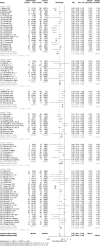How well do different COVID-19 vaccines protect against different viral variants? A systematic review and meta-analysis
- PMID: 39495246
- PMCID: PMC11697103
- DOI: 10.1093/trstmh/trae082
How well do different COVID-19 vaccines protect against different viral variants? A systematic review and meta-analysis
Abstract
While the efficacy of coronavirus disease 2019 (COVID-19) vaccines has been evaluated in numerous trials, comprehensive evidence on how protection by different vaccines has varied over time remains limited. We aimed to compare protective effects of different vaccines against different viral variants. To achieve this, we searched Medline, Cochrane Library and Embase for randomized controlled trials assessing the efficacy of COVID-19 vaccines. Forest plots using Mantel-Haenszel and random-effects models were generated showing risk ratios (RRs) and 95% CIs by vaccines and variants. We included 36 studies with 90 variant-specific primary outcomes. We found a RR of 0.26 (95% CI 0.21 to 0.31) against all variants overall, with the highest protective effects against the wild-type (RR 0.13; 95% CI 0.10 to 0.18), followed by Alpha (RR 0.26; 95% CI 0.18 to 0.36), Gamma (RR 0.34; 95% CI 0.21 to 0.55), Delta (RR 0.39; 95% CI 0.28 to 0.56) and Beta (RR 0.49; 95% CI 0.40 to 0.62) variants. Nucleic acid vaccines showed the highest protection levels against all variants (RR 0.11; 95% CI 0.08 to 0.15), followed by protein subunit, inactivated virus and viral vector. In conclusion, we found high but heterogenous levels of protection for most COVID-19 vaccines, with decreasing protective effects for vaccines based on traditional technologies as SARS-CoV-2 variants emerged over time. Novel nucleic acid-based vaccines offered substantially higher and more consistent protection.
Keywords: COVID-19 vaccine efficacy; meta-analysis; systematic review; viral variants.
© The Author(s) 2024. Published by Oxford University Press on behalf of Royal Society of Tropical Medicine and Hygiene.
Conflict of interest statement
All authors declare that they have no conflicts of interest.
Figures






Similar articles
-
Efficacy of adjuvant-associated COVID-19 vaccines against SARS-CoV-2 variants of concern in randomized controlled trials: A systematic review and meta-analysis.Medicine (Baltimore). 2024 Feb 16;103(7):e35201. doi: 10.1097/MD.0000000000035201. Medicine (Baltimore). 2024. PMID: 38363919 Free PMC article.
-
COVID-19 vaccination efficacy in numbers including SARS-CoV-2 variants and age comparison: a meta-analysis of randomized clinical trials.Ann Clin Microbiol Antimicrob. 2022 Jul 3;21(1):32. doi: 10.1186/s12941-022-00525-3. Ann Clin Microbiol Antimicrob. 2022. PMID: 35786399 Free PMC article.
-
Effectiveness of COVID-19 vaccines against SARS-CoV-2 variants of concern: a systematic review and meta-analysis.BMC Med. 2022 May 23;20(1):200. doi: 10.1186/s12916-022-02397-y. BMC Med. 2022. PMID: 35606843 Free PMC article.
-
Immunogenicity and efficacy of XBB.1.5 rS vaccine against the EG.5.1 variant of SARS-CoV-2 in Syrian hamsters.J Virol. 2024 Oct 22;98(10):e0052824. doi: 10.1128/jvi.00528-24. Epub 2024 Sep 4. J Virol. 2024. PMID: 39230305 Free PMC article.
-
Efficacy, Immunogenicity and Safety of COVID-19 Vaccines: A Systematic Review and Meta-Analysis.Front Immunol. 2021 Oct 11;12:714170. doi: 10.3389/fimmu.2021.714170. eCollection 2021. Front Immunol. 2021. PMID: 34707602 Free PMC article.
Cited by
-
Impact of COVID-19 Vaccination on Hospitalization and Mortality: A Comparative Analysis of Clinical Outcomes During the Early Phase of the Pandemic.Infect Dis Rep. 2025 Jun 27;17(4):74. doi: 10.3390/idr17040074. Infect Dis Rep. 2025. PMID: 40700321 Free PMC article.
References
-
- World Health Organization . Statement for healthcare professionals: how COVID-19 vaccines are regulated for safety and effectiveness (Revised March 2022). WHO [accessed 22 March 2024].
-
- World Health Organization . The impact of COVID-19 on global health goals. WHO. Available at: https://www.who.int/news-room/spotlight/the-impact-of-covid-19-on-global... (2021).
-
- WHO . Tracking SARS-CoV-2 variants. WHO. (2023). Available at: https://www.who.int/en/activities/tracking-SARS-CoV-2-variants/ [accessed 22 March 2024].
Publication types
MeSH terms
Substances
Supplementary concepts
LinkOut - more resources
Full Text Sources
Medical
Miscellaneous

